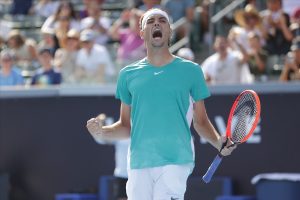As the dominant force in the women’s game, Ashleigh Barty has stunned the tennis world by retiring at just 25 years old.
Since winning the French Open in 2019, Barty was the player to beat–holding the world number one spot for all but four weeks until her retirement. She won in front of the world at Wimbledon and followed it up with victory at her home Grand Slam in Australia, where she did not drop a set.
In a WTA that is famous for its unpredictability, her consistency was almost spellbinding. Her variety could counter the strengths of any opponent, while her all-court game allowed her to adapt to any surface with ease. Her serve was supreme, particularly for a player of relatively short stature.
At just 25, there is no doubt that she had much more to give if she wanted to. However, her relationship with tennis was always a complicated one. After achieving so much in such little time, she feels this is the time to depart on her own terms, and focus on other goals.
She is not the first to bow out early, though. Here are three other superstars of the game who left at a young age.
Justin Henin
The Belgian is the most obvious comparison to Barty. The seven-time Grand Slam champion retired in May 2008, and just like Barty, was also ranked World #1 and aged 25. She was just weeks away from defending her French Open title, where she was the three-time defending champion.
However, unlike Barty, whose record was 11-0 this year, Henin was struggling with injuries and relatively poor form at the time of her retirement. As she battled against the fatigue of life on tour, tennis just did not hold the same excitement. Her inspiration came from elsewhere, particularly her charitable foundation, which helped children sick with cancer. By Henin’s own admission, retirement came as a relief.
It wouldn’t be the end though. After 16 months, Henin would return to the circuit in a successful period, even winning the WTA’s Comeback Player of the Year Award in 2010. Sadly, injury problems forced her to retire in 2011 for the second and final time.
Bjorn Borg
Borg’s shock retirement at 26 remains the reference point for all players who leave the game before their time. The 11-time Major winner was such a colossal force in tennis that even his rival John McEnroe tried to persuade him to continue. It was understandable too – Borg had elevated tennis to new heights of popularity. No one wanted to imagine a world without him.
It was never clear why Borg hung his racket up in 1983, but at that moment, tennis no longer had the same appeal for the iconic Swede. Some have said that his defeat in the 1981 US Open to McEnroe was the catalyst, as he would play just one more tournament before calling it a day.
But as we all know, he would be back again. Eight years later, in 1991, Borg attempted a comeback, physically out of shape and amazingly still using a wooden racket even as the world had moved on to graphite. The results were unsurprisingly poor, but after years of financial and personal problems, tennis once again gave him joy.
Martina Hingis
Before Roger Federer, Switzerland had Martina Hingis. Her career is one of return and reinvention, of amazing highs and desperate lows. Few have ever been so successful at such a young age. She won three Grand Slams in 1997 while still 16 years old. In 1998, she completed the Doubles Grand Slam, winning all four women’s doubles Majors in a calendar year.
It was astonishing, especially for a teenager. Hingis had carved out a Hall of Fame career in just a couple of years. Then the injuries came. A series of ankle problems led to her retirement at just 22 years old. She had already won 76 titles in total.
In 2006, she was back again (spotting a trend yet?), and while her success was nothing like as spectacular as her teenage years, she nonetheless climbed to World #6. A controversial drugs suspension and hip injury led to a second retirement at the end of 2007.
Yet this wasn’t the end. In 2013, Hingis returned yet again, solely to focus on doubles. It was a superb closing chapter to her career–winning 10 doubles Grand Slams in just four years. When she retired in 2017, she was once again ranked World #1.
Main Photo from Getty.






